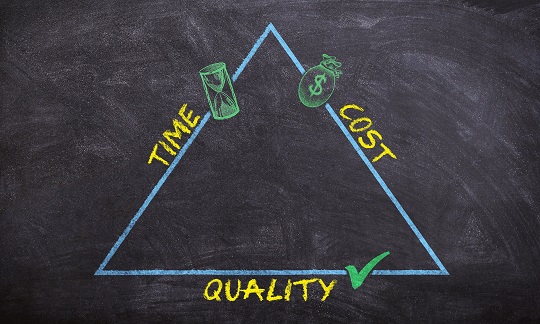Profit erosion can be a significant challenge for businesses, especially when faced with rising costs and fierce competition. To mitigate this issue, businesses often grapple with the decision of whether to raise prices or reduce costs.
This blog post will delve into the factors that should be considered when making this crucial choice and explore the consequences of each option for your business.
Furthermore, we will examine the best practices and ideal scenarios for implementing price increases and cost reductions.
But before we delve deeper, make sure you have joined the scmguide telegram channel to receive notifications of the latest posts from this blog as well as more insights on supply chain management.
Table of Contents
Evaluating the Factors
Before making any decision regarding price increases or cost reductions, it is crucial to thoroughly assess several factors that have a direct impact on your business’s profitability.
By considering the following points, you can make an informed decision.
Market Dynamics
Start by analyzing the demand elasticity for your product or service. Determine whether it is a necessity or a luxury in the eyes of your customers.
Understanding customer behavior and their price sensitivity will help you gauge the feasibility of raising prices without sacrificing sales volume.
For instance, if your product is highly demanded and customers perceive it as essential, you might have more flexibility to increase prices.
Competition
Evaluate the competitive landscape in which your business operates. Are your competitors raising prices or cutting costs?
Assessing the market dynamics will provide valuable insights into your pricing strategy and the potential impact on your market share.
If your competitors are raising prices successfully, it may indicate that customers are willing to accept higher prices, making it a viable option for your business as well.
Cost Structure
Conduct a detailed analysis of your cost structure to identify areas where cost reductions are possible.

Look for inefficiencies, redundancies, or unnecessary expenses that can be eliminated without compromising the quality of your product or service.
This assessment will help you understand the scope for cost optimization and identify potential cost-saving measures.
Value Proposition
Evaluate the value your product or service provides to customers compared to the competition.
Assess whether you offer unique features, exceptional quality, or superior customer service.
If your business differentiates itself in the market and provides significant value to customers, you may have more leeway to increase prices without losing customers.
Customers are often willing to pay a premium for products or services that offer exceptional benefits or solve their pain points effectively.
Customer Relationships
Consider the strength of your customer relationships and the level of loyalty they have towards your brand.
If your customers have a strong emotional connection with your brand and value the offerings you provide, they may be more understanding and accepting of price increases.
However, it is important to communicate the reasons behind the price increase clearly and transparently to maintain trust and minimize any potential negative impact on customer relationships.
You might also like:
- Overproduction Dilemma: Balancing Fixed and Additional Costs in Supply Chain
- Closing Down a Manufacturing Plant: Options, Challenges, and Strategies for a Smooth Transition
Price Increases Benefits and Consequences
Benefits
Immediate Impact on Profitability
One of the primary benefits of implementing price increases is the direct boost to revenue and improved profitability.
By raising prices, you increase the amount of money coming in for each sale, which can have an immediate positive impact on your bottom line.
Preserving Brand Image
Higher prices can convey a sense of exclusivity and quality, positioning your brand as a premium option in the market.

When customers perceive your products or services as higher in value, they may be willing to pay a premium price, strengthening your brand image and enhancing its perceived value.
Sustainable Growth
Higher profit margins resulting from price increases can support long-term business growth.
With increased profits, you can reinvest in your business by allocating resources towards innovation, expansion, enhanced customer experience, and other strategic initiatives that drive sustainable growth.
Consequences
Customer Resistance
One of the main concerns when raising prices is customer resistance.
Customers may become dissatisfied or seek alternative options if they perceive that the value does not justify the higher cost.
It is crucial to communicate the reasons behind the price increase clearly, emphasizing the value they will receive in return.
Competitive Pressure
Price increases may invite competitive pressure from rivals who respond with aggressive marketing or lower prices to lure customers away from your business.
Competitors might view your price increase as an opportunity to gain market share, and you need to anticipate and strategize accordingly to maintain your competitive position.
Demand Elasticity
Successful price increases often require a certain level of inelastic demand, where customers are less sensitive to price changes.
If demand for your product or service is highly elastic, a significant price increase may result in a substantial decrease in sales volume.
Assessing the demand elasticity of your offerings is crucial to determine the feasibility and potential impact of price increases.
Cost Reductions Benefits and Consequences
Benefits
Immediate Cost Savings
Implementing cost reduction measures can directly improve profitability by lowering expenses.
By identifying and eliminating inefficiencies, streamlining processes, renegotiating supplier contracts, or optimizing resource allocation, you can achieve immediate cost savings that positively impact your bottom line.
Competitive Advantage
Cost reductions can enable you to offer lower prices compared to your competitors.
This competitive advantage can attract price-sensitive customers who prioritize affordability.

Lower prices can also help you gain market share or maintain a competitive position in price-driven markets.
Flexibility in Pricing
Lowering costs provides room for strategic price adjustments.
With reduced expenses, you can be more responsive to market dynamics, such as fluctuating demand, changing customer preferences, or competitive pressures.
Flexibility in pricing allows you to optimize your pricing strategy for better market penetration or profitability.
Consequences
Quality Compromises
It is essential to strike a balance between cost reduction and maintaining product quality.
Overemphasizing cost reductions without considering the impact on quality can lead to compromised products or services, damaging your brand reputation and customer satisfaction.
Careful evaluation is necessary to ensure that cost-saving measures do not negatively affect your offerings.
Diminished Innovation
Cost-cutting measures may limit investments in research and development, hindering future growth and competitiveness.
While cost reductions can be beneficial in the short term, it is crucial to assess the long-term impact on innovation and the ability to adapt to evolving market needs.
Strive for a balance between cost optimization and investment in innovation.
Supplier Relationships
Drastic cost reductions may strain relationships with suppliers.
Suppliers might face challenges in meeting quality standards or maintaining reliable supply if prices are drastically reduced.
Maintaining healthy supplier relationships is essential for a smooth supply chain operation and ensuring consistent product or service delivery.
You might also like:
- The Ultimate Guide to Raw Material Price Negotiations for Small Volume Customers
- Spot Purchasing vs. Contracts: Which is the Right Choice for Your Raw Material Needs?
Best Practices and Ideal Scenarios
Raising Prices
Gradual Adjustments
When implementing price increases, it is advisable to do so gradually rather than making sudden and significant changes.

Gradual adjustments allow customers to adapt to the new pricing structure and minimize the risk of customer resistance.
Incremental increases over time can be more easily absorbed by customers, reducing the likelihood of losing them to competitors.
Value Communication
Effective communication is key when raising prices.
Clearly articulate the value proposition to your customers, emphasizing the additional value they will receive in return for the increased price.
Highlight any enhancements, improvements, or added benefits that justify the price increase.
Show how the increased cost is justified by the improved value they will experience.
Monitor Competitor Behavior
Keep a close eye on your competitors’ pricing strategies.
Monitor their pricing changes and assess how the market responds to those adjustments.
This will provide insights into the market’s tolerance for price increases and help you make informed decisions.
Understanding how your competitors navigate price increases can guide your own pricing strategy and position your business competitively.
Cost Reductions
Continuous Improvement
Embrace a culture of continuous improvement within your organization.
Encourage employees to identify and eliminate inefficiencies throughout your operations. This can include streamlining processes, reducing waste, optimizing resource allocation, and enhancing productivity.
By consistently seeking ways to improve efficiency, you can achieve ongoing cost reductions without sacrificing quality or customer satisfaction.
Supplier Negotiations
Establish strong relationships with your suppliers and actively engage in negotiations to seek favorable terms.
Explore opportunities to secure cost savings through volume discounts, longer-term contracts, or improved payment terms.
Effective supplier negotiations can help you reduce costs without compromising the quality of your inputs or disrupting the supply chain.
Process Optimization
Analyze and optimize your internal processes to enhance productivity and achieve cost savings.
Identify areas where bottlenecks occur, redundancies exist, or tasks can be streamlined.
Implement automation or technology solutions where applicable to improve efficiency and reduce labor costs.

Process optimization ensures that resources are utilized effectively and eliminates unnecessary expenses.
In ideal scenarios, a combination of both price increases and cost reductions can be employed to maximize profitability while maintaining customer satisfaction and competitive positioning.
By following these best practices, you can strike a balance between revenue growth and cost optimization:
- Assess market dynamics, competition, and customer behavior to determine the feasibility of price increases.
- Implement gradual price adjustments to minimize customer resistance.
- Communicate the added value to customers to justify the price increase.
- Monitor competitors to evaluate the market’s response and make informed pricing decisions.
- Foster a culture of continuous improvement to identify and eliminate inefficiencies in your operations.
- Seek opportunities for favorable supplier negotiations to secure cost savings.
- Optimize internal processes to enhance productivity and reduce costs.
However, it is important to recognize that each business is unique, and there may be specific considerations that influence your decision-making process.
Evaluate the specific circumstances of your industry, market, customer base, and financial goals to determine the most suitable approach for your business.
Regularly review and reassess your pricing and cost management strategies to adapt to changing market conditions and ensure long-term profitability.
Conclusion
When faced with profit erosion, the decision between raising prices and reducing costs requires careful consideration.
Assessing market dynamics, competition, cost structure, value proposition, and customer relationships is crucial in making an informed choice.
Price increases can lead to immediate profit improvements but carry the risk of customer resistance and competitive pressure.
On the other hand, cost reductions offer immediate cost savings and competitive advantage, but can result in compromises on quality and innovation.
The best practices for price increases include gradual adjustments and effective value communication, while cost reductions require continuous improvement and smart supplier negotiations.
Ultimately, the ideal approach may involve a combination of both strategies, finding the right balance to preserve profitability while maintaining customer satisfaction and competitive positioning.
Remember, each business is unique, so it is vital to evaluate the specific circumstances and goals of your business before implementing any changes.
Hope it is useful!
Please also share this article with your colleagues so that they can benefit from it as well. Join our scmguide telegram channel to receive notifications of the latest posts from this blog and gain more insights into supply chain management. All articles on this blog are free for you to use for any purpose, including commercial, without the need for attribution.

 by
by 

